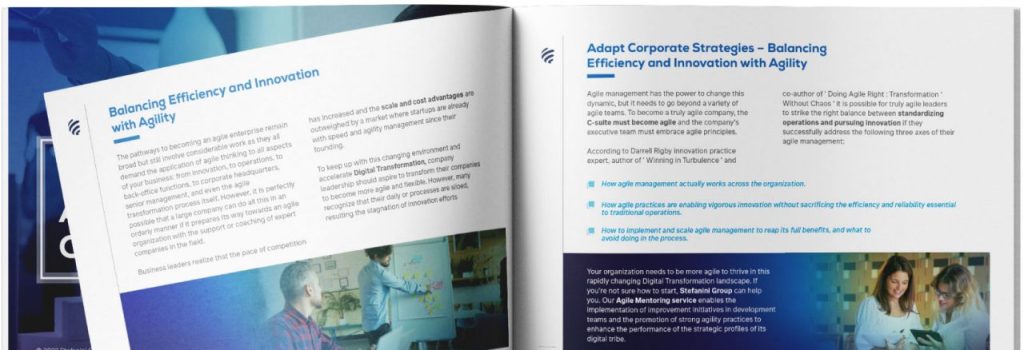- What Caused the Baby Food Formula Shortage?
- The Need for agile in Supply Chain Management to Boost Baby Formula Production
- Success Factors for Supply Chain Resiliency
- Enable Agile Supply Chain Management with Stefanini
The national shortage of infant formula began earlier this year due to preexisting supply chain issues. However, the situation worsened due to a major formula recall in February 2022 and the subsequent shut down of a major formula plant. While the white house has taken efforts to intervene in the crisis, food production manufacturers continue to struggle in their efforts to address the shortage amidst a broken supply chain.
While there is no perfect solution to solve the shortage, the Agile methodology offers a means for manufacturers and stakeholders across the supply chain to address the challenges of disruption. This article aims to give context to the formula shortage and show how Agile can bring meaningful change to this crisis.

What Caused the Baby Food Formula Shortage?
In large part, the national shortage of baby formula was fueled by the shutdown of a leading production plant run by Abbott Nutrition in February because of contamination concerns. Even before the shutdown, Abbot announced it was voluntarily recalling tree types of infant formula after four babies became sick with bacterial infections after consuming the brand of formula in question.
The food and drug administration (FDA) had received three consumer complaints about Cronobacter sakazakii, a bacterium that can cause severe, life-threatening infections or inflammation of the membranes that protect the brain and spine.
Dr. Robert M. Califf, the commissioner of the Food and Drug Administration, told a House panel that the Sturgis plant had a roof leak that caused water to pool on the plant floor and in cracks on production equipment causing bacterial contamination. Califf detailed “egregiously unsanitary” conditions but also acknowledged that the agency was slow in addressing problems at the plant.
However, Abbott has said that there was no “conclusive evidence” to link the company’s formulas to the illnesses. Regarldess, Abbott’s voluntary closure of its plant doors, exacerbated supply chain problems that resulted from pandemic disruptions that had already been escalating for months. Out-of-stock rates soared to about 74% at stores across North America as of the week ending May 28, according to Datasembly.
As social media networks brought attention to dwindling supplies, parents rushed to stock up on formula, frequently traveling for hours to find empty shelves. Even though specialists advise regular formula or breast milk as essential sources of nutrition from birth to a baby’s first birthday, some parents in particular regions have been so desperate that they have fed their infants powdered oatmeal porridge, solid foods, and fruit juice.
In response to the crisis, several government organizations have taken efforts to support impacted families. The American Academy of Pediatrics (AAP) sent two letters to federal officials requesting swift action at all levels of government to boost the availability of safe baby formula throughout the country.
As part of the Biden-Harris Administration’s coordinated effort to end the infant formula shortage, The U.S. Department of Agriculture (USDA) has urged states to take advantage of flexibility the department is offering in the Special Supplemental Nutrition Program for Women, Infants, and Children to help families get the safe formula they require. Additionally, President Biden announced that he would invoke the Defense Production Act, meaning suppliers will be required to give resources to infant formula plants before sending them to other customers.
The Severity of this situation cannot be understated, and families struggling from the shortage should visit Health and Human Services (HHS) for some tips on finding safe substitutes.
As of June 2022, the Abbott plant site has reopened and restarted production of EleCare and other formulas. A regulator stated Abbott had agreed to take corrective actions following an inspection of its facilities, which would “ultimately result in an increase of infant formula products, while ensuring that the company undertakes certain actions that would ensure safe powdered infant formula is produced at the facility.”
Stefanini Agile Solution Squads will help deliver the best business results for you. Click here!
The Need for Agile in Supply Chain Management to Boost Baby Formula Production
The key issue the led to the Abbot Plant closure was an inability or slow response from both Federal agencies and plant personnel to recognize and address unsanitary conditions. This coupled with national supply chain crawl highlight the necessity of having a swift means of addressing disruption.
The Agile Methodology can enable baby food manufacturers and supply chain stakeholders alike to address these challenges. Presently, Only 27.4% of manufacturing companies rely entirely on Agile while 56.6% of manufacturing companies rely on a combination of methodologies, including Agile (Zippa).
From a business perspective, agility is defined as a strategy that is more responsive in a volatile market place, where strategy is totally demand driven. Agile eliminates the chance of spending months or years on a process that ultimately fails due to initial errors.
How is AI transforming business supply chains? Read the Trends blog and find out!
Success Factors for Supply Chain Resiliency
Agile does not guarantee success on its own but instead requires people and organizations to create open and accurate communicate communication channels with each other and with consumers. Speed, cost, and efficiency are the three main propellers of an agile supply chain. Flexible supply networks are built on the ability to respond quickly to consumer demand.
Here are four success factors that define Agile Supply Chain resiliency:
- Network-Based Responsibility: To ensure success, each actor across the supply chain must take efforts to ensure the system works effectively. The task of making changes and responding to disruptive pressures is shared and defined by each actor’s core abilities. Since each actor in the chain orchestrates with the others, responsibility for the chain’s success is shared equally. This lowers the pressure on individual actors, but each end is affected by the actors’ performance.
- Virtual Integration: Information is shared between the relevant departments and stakeholders in order to meet shifts in customer or market demand. As forecasted demand data is acquired, stakeholders work together to determine how to meet demand and responds in accordingly. In this sense, virtual integration creates end-to-end visibility, making it simple to identify bottlenecks any network or other concerns that may cause slowdowns.
- Process Alignment: Achieving effective process alignment requires the implementation of a Synchronous supply chain. Currently, most supply chains are controlled through vendor managed inventory (VMI). Co-managed inventory offers a sophisticated alternative that tracks inventory changes across several locations and keeps stakeholders notified.
Likewise, collaborative product design enables teams to define consumer the needs or wants and make changes in response to sudden disruption.
- Market Sensitivity: Modern chains must be responsive to market shifts. Demand forecasting is dependent on daily Point of Sale (P.O.S.) data. The prior system of anticipating demand based on historical trends is an outdated method as modern marketplaces are subject to heightened volatility. In order to forecast future demand, daily feedback from the market or sales terminal is collected.
Similarly, creating channels that allow stakeholders to listen to the opinions of the final consumer can determine the supply chain’s success as the actual demand that should drive supply is the voice of the consumer.
Next-Gen logistics management solutions can improve your manufacturing business. Click here!
Enable Agile Supply Chain Management with Stefanini
The Infant formula shortage highlights how severely disruptions in the supply chain can impact people’s lives. However, the agile methodology offers a means for businesses and stakeholders at each stage of the value chain to prepare for and navigate sudden changes in the market.
Stefanini operates with co-creation mindset centered on balancing innovation and efficiency. Our team can help you implement Agile Supply Chain management strategies and more.
Speak with an expert today!




















